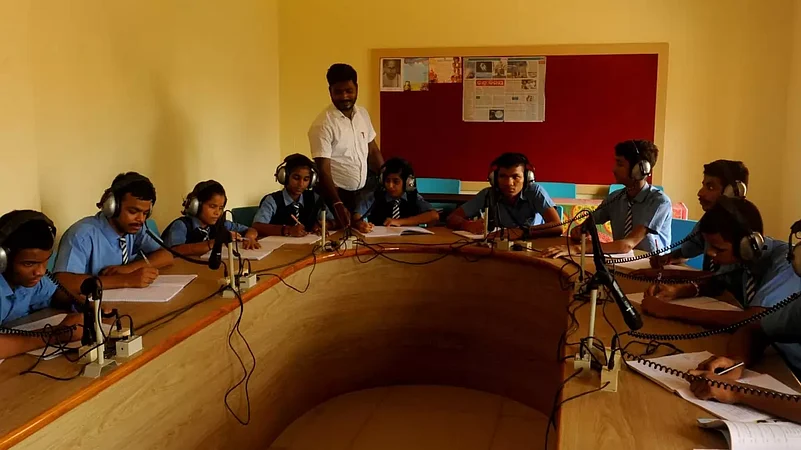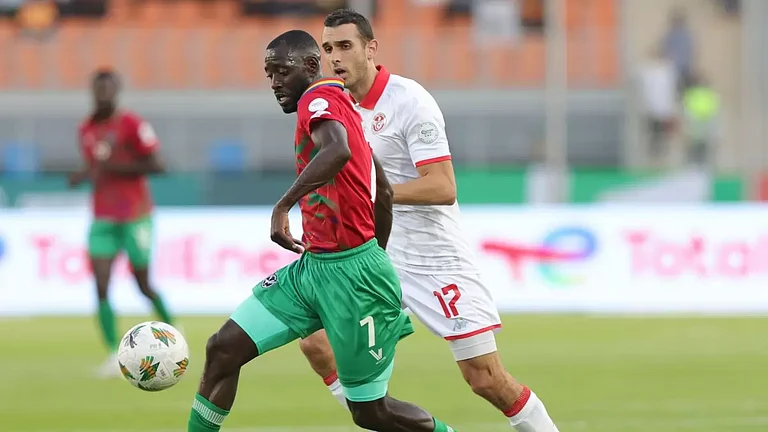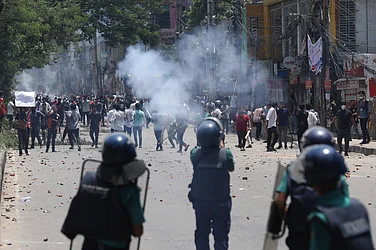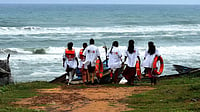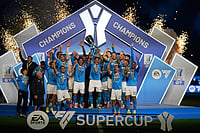For parents, hearing the first word that their child utters is a joy that cannot be described. But it is not so for the parents of Subhashree Nayak, now 12. They never got to hear those words—she was born with moderate hearing and speech disabilities. The little girl herself silently endured the pain of being ignored by people around her, including her siblings. That was before she was brought to the Disability Innovation and Experience Lab (DIEL) at the Odisha government’s Integrated Infrastructure Centre (IIC), run by the Department of Social Security and Empowerment of Persons with Disability (SS&EPD) in collaboration with the United Nation Population Fund (UNFPA), in Jatni on the outskirts of Bhubaneswar.
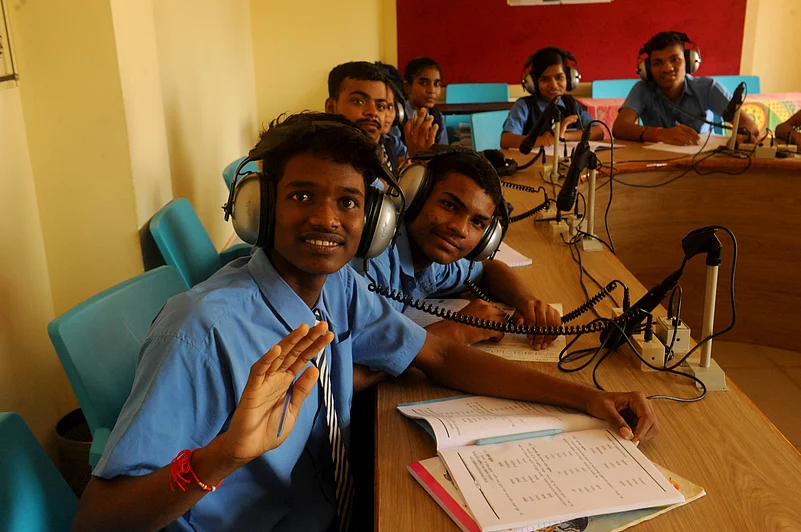
The lab, established in December last year, is an interdisciplinary innovation hub dedicated to empowering persons with disabilities, especially adolescents through experience and exposure to Assistive Technology, screening of disabilities, training of special educators, design innovations of existing technologies, and inculcating critical life skills education. For instance, Nayak’s speech trainer at DIEL is a life-reforming machine that harnesses the residual hearing capacities of people with hearing disability. The lab’s mission is to improve the quality of life of children and adolescents with disabilities by harnessing the power of technology, design and innovation, and promote a more accessible, empowering and inclusive society.
The Gift of Speech
For Snehanjani Das, assistant speech therapist at the Sriharsa Mishra School for the Deaf in the IIC complex, the work begins with identifying the speech capacity of the children by assessing their ability to utter the Ling 6 sounds—aa, ee, oo, sh, ss and mm. “I begin by finding out the speech capacity of a child, depending on her or his ability to pronounce one or more of the six Ling sounds,” Das says. This complex process, Kumar Raju, a programme manager at DIEL, explains is aimed at working on the speech of children who have hearing disability but not necessarily speech disability. The training can help children like Subhashree express themselves using words. “She will not need to depend entirely on the use of sign language to communicate,” he says.
The extent to which the current technology can help young people with hearing disability depends on the degree of their disability, explains Debabrata Behra, an assistant teacher at the IIC. He explains that people with hearing disability can be categorised on the ability of their residual hearing—mild, moderate or severe hearing disability. According to Behra, 70 percent of such children have mild or moderate hearing disability, and modern instruments like behind- or in-the-ear hearing gadgets and the speech trainer, along with support from therapists like Das, can be quite beneficial for them. The remaining 30 per cent—the ones with severe hearing disability—will have to wait until further technological advances are made in therapy.
Giving Them an Ear
The UNFPA experiment at the Sriharsa Mishra School aims to create an enabling ecosystem for the young through its disability laboratory. Once Subhashree can use her vocal cords to communicate and listen with the help of her in-the-ear hearing aid, she will be ready to step into one of the school’s smart classrooms and sit amid a loop-induced electromagnetic field that sends the teachers’ oral instructions to the telecoil in the hearing aid device.
These assistive technologies are a part of the disability lab’s ecosystem, and the ability to listen inside a looped classroom is but an initial goal that must conform to a series of pedagogically defined steps that will help improve the lives of individuals.
The impact of the modern scientific Assisted Technology (AT) led pedagogical approach to gain life skills education like critical thinking, creativity and communication is apparent in the excitement of the students. One of them is 14-year-old Antariksha Pattanayak who has hearing speech and locomotive disabilities because of congenital conditions. Pattanayak, a student in Grade 8, has been introduced to AT games to learn about collaboration to achieve larger goals. But more importantly, he has playmates and peers who face challenges like his own. Just like him, Nayak too feels at home at the IIC, with fellow students who are together in the process of challenging their disabilities.
Reading it Right
Her first visit to the disability lab has been a life-changing experience for 14-year-old Abhilipsa Panda who cannot see. A student of the Louis Braille School, Abhilipsa finds the environment welcoming. She is hesitant but, at the same time tempted by possibilities that the gadgets and contraptions throw open for her.
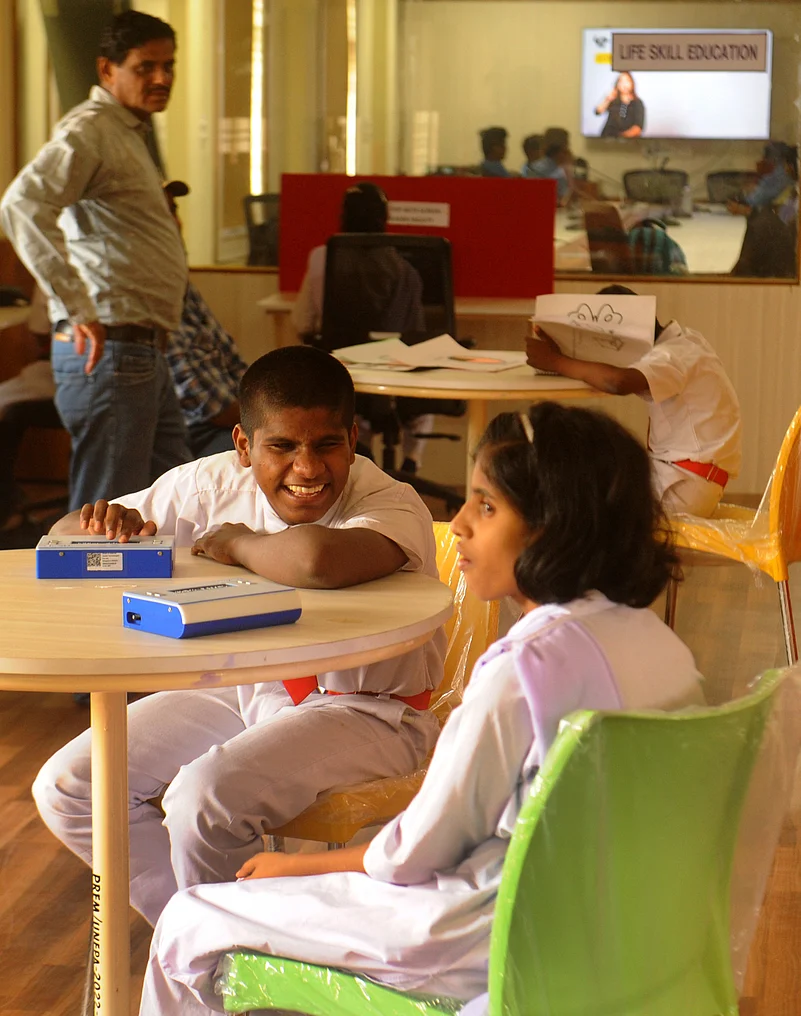
At DIEL, Abhilipsa is introduced to a range of teaching aids that will complement her braille lessons. The skills she has acquired over the system of touch reading of the raised braille dots come in handy on a new machine she is introduced to. Called Hexis, it is a kindle-like appliance made to help children with visual disabilities read without the hassles of braille. Producing braille books is an expensive job. Also, these books are not always available at schools. These books are bulky, and the dots get blurred by friction from the fingers of the many students who use a single book.
A technological leap over braille, Hexis aims to enhance literacy skills and performance outcomes by inputting the content of many books into one machine for students to scroll through as the dots rise word after word, line after line and page after page. Hexis enables children with visual disabilities to read more than their school lessons—almost anything available over the digital medium can be run into the Hexis device to be made accessible to these students.
On the day of her visit, Abhilipsa is introduced to the braille-like machine. She realises that it is different and that it will help her read many more books. She is also introduced to perceptible tactile diagrams that help her learn science. A tactile diagram of the human anatomy explains the complex workings of different organs. It has parts lifted over a membrane and gives a fair clue of the functioning of different organs. In schools for visual disability, teachers have conventionally left out these portions of the syllabus, says Panda, adding that now the teachers too are being trained so that students with visual disabilities no longer miss out on important parts of their lessons just because they cannot see.
“I knew about plants because I have felt those growing outside. But I did not have an idea of the human heart. Here, I got to touch a tactile diagram that was physical in nature,” says Abhilipsa. “This is so different,” she beams, as she “reads” the braille accompaniments on the tactile diagram to identify each part of the heart.
Being in the lab, playing, learning, sharing and experiencing are activities that also enrich the entire paradigm of traditional Life Skills Education that students like Abhilipsa are experiencing for the first time at DIEL. She aspires to become a teacher one day. The ability to stay happy and expand the horizons of their knowledge is what the assistive technologies in the DIEL lab provide to these youngsters.
On the Path to Empowerment
Around 90 per cent of the students at the DIEL are adolescents. At the lab, they are also being made aware of the changes in their bodies. Helping them understand and come to terms with these changes require different skills, but the upside is that it also tells them that despite their challenges, they are not very different from others.
The Odisha government recently decided to cover all its 104 special schools under 5T — teamwork, technology, transparency, transformation, time — with a focus on the most vulnerable sections of society, like persons with disabilities. Dilip Ray, Special Secretary of the Social Security and Empowerment of Persons with Disabilities Department (SS&EPD), says that this is a significant step towards providing children having special needs with quality and accessible education. “The initiative is one giant leap towards improving the quality of educational experiences for children and adolescents with disabilities,” he says.
Covering special schools under the 5T initiative is important for children and adolescents with disabilities as it assures infrastructural improvements, accessibility features, and investments in technology. The initiative has made DIEL the benchmark for innovating, designing and testing various assistive technological, intellectual and pedagogical tools for persons with disabilities. This works in tandem with its school readiness programme that aims for a smoother transition of children from special to regular schools.
With the state-of-the-art assistive technologies at its disposal, DIEL is set to be a resource centre for all categories of children and adolescents with disabilities and to help build the capacities of caregivers, schoolteachers and special educators in special curriculum and life skill education programmes.
“Our focus is on information technology. It is the mantra as we want to transform the schools and here technology is the most important part,” says Ray of SS&EPD. Ray calls the experiment in DIEL an oasis, adding that there is an effort to replicate this in other schools under the department. The collaboration with UNFPA, he says, is attracting teachers and students to the IIC, giving them exposure and hands-on training and providing them with an atmosphere for joyful learning.
“In future, we plan to set up disability labs in all district headquarters. We are building IICs in each district. Six have already come up. We are trying to build 30 IICs in the state,” he says, emphasising the need to replicate the success of the joint endeavour of the government and the UNFPA. The proof of the pudding, as they say, lies in its taste. The government’s willingness to replicate the success of the DIEL initiative speaks volumes of its success. Meanwhile, the disability lab continues to make efforts to bring its young students as close as possible to the life that people around them lead.
The joy of families when the young students at IIC grasp their therapists’ instructions with listening aids, exercise their vocal cords over a spirometer and begin uttering their first few syllables, is unmatched.
To understand how the lab is empowering the children, take the example of Subhashree Nayak’s eagerness to express herself in her own words, the sound of which will be uniquely hers.
(Author's Bio: Bijoy Patro is a senior journalist.)






